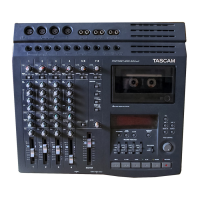
Do you have a question about the Tascam PortaStudio 424 MKII and is the answer not in the manual?
| Brand | Tascam |
|---|---|
| Model | PortaStudio 424 MKII |
| Category | Cassette Player |
| Language | English |
Explains the PORTASTUDIO 424 MKII as a complete audio production facility.
Lists necessary input/output devices and other equipment for a complete recording system.
Details the three main steps: TRACKING, OVERDUBBING, and MIXDOWN.
Illustrates the input signal path through the 424 MKII Mixer section to the LINE OUT jacks.
Describes the function and importance of TAPE CUE and MONITOR switches for headphone monitoring.
Explains how the CUE mix is independent from the Main Mix and prevents accidental track bouncing.
Highlights features like 4 tracks, stereo output, DIRECT feature, and dbx Noise Reduction.
Details microprocessor-operated transport controls for reliable functions.
Explains the HIGH speed (9.5 cm/sec) and discrete 4-channel format head.
Discusses playing back standard stereo tapes and the limitations of the 424 MKII on stereo decks.
Specifies HIGH BIAS "Type II" tape and recommends quality brands for best results.
Explains how to punch out record protect tabs to prevent accidental tape erasure.
Advises using shorter cassette lengths and avoiding C-120 tapes for reliable operation.
Details MIC/LINE INPUTS, SUB INPUTS, and their connection types (XLR, 1/4").
Describes TRIM, INPUT select, EQ controls, EFFECT sends, TAPE CUE, and PAN.
Details STEREO INPUTS, Mono Feature, LEVEL, and ASSIGN switches for channels 5-8.
Explains EFFECT 2/TAPE CUE, MASTER fader, and their functions.
Details MONITOR switches and MONITOR LEVEL for headphone monitoring.
Covers REHEARSAL, AUTO IN/OUT, REPEAT, MEMO IN, RTZ, LOC 1/2, and PITCH CONTROL.
Explains RECORD FUNCTION switches, REC indicators, and track metering.
Describes the tape counter, DBX NR switch, and their functions.
Details TAPE OUTPUTS, LINE OUTPUTS, MONITOR OUTPUTS, and EFFECT SEND jacks.
Covers PHONES jack and REMOTE PUNCH IN/OUT jack.
Guides through making input connections, powering on, and headphone setup.
Explains how to set the INPUT select switch for microphone/line sources.
Details Panning, faders, monitor selection, TRIM, and listening level adjustments.
Guides on loading a cassette and advancing past the leader tape.
Covers counter reset, record function, and mic level adjustment for recording.
Details starting recording, stopping, and setting the track to "Safe" mode.
Explains activating TAPE CUE and selecting monitor sources for playback.
Guides on tape locating, playing, adjusting level, and routing signals.
Details input routing, panning, channel/master levels, and monitor selection.
Covers tape locating, track selection, and adjusting the record level (TRIM).
Details initiating record, monitoring, stopping, and setting tracks to "Safe" mode.
Explains how to record many sources onto a single track using mixer channels.
Reinforces recording many sources onto a single track with PAN control settings.
Explains recording a mix onto two tracks using PAN and RECORD FUNCTION.
Details recording on three or four tracks at once using the DIRECT function.
Explains recording stereo channels (5-6, 7-8) for up to six sources simultaneously.
Details connecting to a mixdown deck and setting master/monitor levels.
Guides on setting channel faders, PAN, and EQ for the final mix.
Covers checking the sound balance, level, and tonality, and rewinding to check the result.
Explains putting the mixdown deck into Record Ready and adjusting input levels.
Explains setting and loading autolocation points (MEMO 1 and MEMO 2).
Covers recalculating, checking, and erasing MEMO points.
Details using RTZ, LOC 1, and LOC 2 keys for tape positioning.
Explains initiating auto play or auto pause after reaching a location point.
Guides on establishing loop points (MEMO 1 & 2) and activating the REPEAT function.
Explains how to stop, interrupt, and resume the REPEAT sequence.
Covers input routing and setting up monitor controls for punch-in recording.
Discusses choosing precise points for smooth inserts and the use of REHEARSAL.
Explains how to rehearse punch-in without affecting the recording.
Details how to store punch-in and out points into memory using REHEARSAL.
Describes performing the actual auto punch-in/out after rehearsal.
Explains how to change or quit rehearsal mode and the limitations of the function.
Details executing the rehearsed sequence with AUTO IN/OUT and PLAY.
Explains manual punch-in using the RECORD button or footswitch.
Details combining tracks 1-3 onto track 4 with specific mixer settings.
Explains direct instrument-to-effect-to-mixer processing.
Describes using EFFECT SENDs and STEREO INPUTs for external effects.
Guides on setting EFFECT send levels, output levels, and mix/balance controls.
Explains using STEREO INPUTS for mono returns and patching effects to input channels.
Details how to monitor reverb in headphones or record it onto a track.
Details MIC/LINE INPUTS, SUB INPUTS, TRIM, and INPUT select switches.
Explains the function of EQ HIGH, MID, LOW, and EFFECT 1/2 send controls.
Covers PAN, Fader, STEREO INPUTS, LEVEL, and ASSIGN switches.
Details MONITOR switches, LEVEL, EFFECT 2/TAPE CUE, MASTER fader, and outputs.
Describes TAPE OUTPUTS, PHONES, and REMOTE PUNCH IN/OUT connections.
Covers cassette loading, tape path components, and the DBX NR switch.
Explains RECORD FUNCTION switches, REC indicators, meters, and tape counter.
Details RTZ, LOC 1/2, MEMO IN, and REPEAT functions for tape navigation.
Emphasizes regular cleaning of heads and tape guides for optimal performance.
Guides on activating and using the cleaning mode for heads and pinch roller.
Details cleaning the pinch roller, capstan shaft, and degaussing the tape path.
Explains the wide-band compression-expansion system for noise reduction and dynamic range.